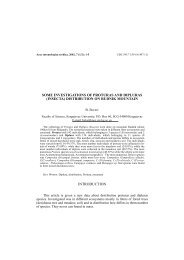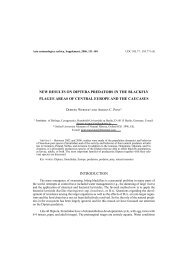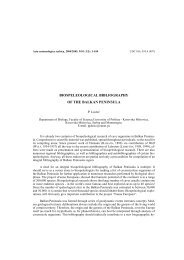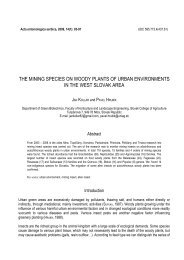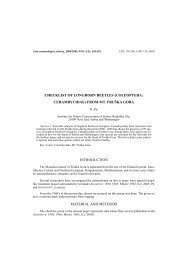Ćetković, A., Mokrousov, M., Plećaš, M., Bogusch, P., Antić, D ...
Ćetković, A., Mokrousov, M., Plećaš, M., Bogusch, P., Antić, D ...
Ćetković, A., Mokrousov, M., Plećaš, M., Bogusch, P., Antić, D ...
Create successful ePaper yourself
Turn your PDF publications into a flip-book with our unique Google optimized e-Paper software.
102 A. ĆETKOVIĆ et al.<br />
Obviously, none of the above country records, except for Russia and Montenegro, was based on correct<br />
facts. Given the growing interest in the detection and monitoring of the invasive (and potentially invasive)<br />
species, we consider it very important to eventually rectify the ongoing perpetuation of published errors<br />
regarding S. deforme status in Europe, and to provide reliable evidence about the course of its introduction.<br />
Sceliphron deforme: History of spreading – current state of evidence<br />
As shown in the list of material, the earliest known specimens of S. deforme in the Nizhegorodskaya Oblast<br />
were collected in 1984, but according to observations of older colleagues (personal communication of MM), it<br />
appeared in this area even some years earlier. The very location of Staraya Pustyn' is the biological (field)<br />
station of the Nizhegorodsky State University, which regularly organised scientific/educational visits to central<br />
Asia and Russian Far East during the 1970s and 1980s. Therefore, the most plausible scenario of<br />
introduction could be a deliberate transportation of wasps’ nests, possibly for rearing experiments. An<br />
alternative possibility would be a merely accidental transportation of nests (as unintentional shipment), which<br />
although considered common in numerous other cases of Sceliphron introductions (SCHMID-EGGER, 2005;<br />
etc.), is not so easily conceivable in this case.<br />
The established population of S. deforme in the Nizhegorodskaya Oblast agrees with ssp. atripes (Morawitz,<br />
1888), as defined by HENSEN (1987). This relatively dark subspecies inhabits the extensive northern part of<br />
the species range in Asia: from eastern Kazakhstan to Primorskiy Kray and Korea, including southern<br />
Siberia, Mongolia and parts of northern China. The distance between the Nizhegorodskaya Oblast and the<br />
nearest known occurrence within its native range is about 2,400-2,500 km (Kazakhstan: Karzhantau and<br />
Semipalatinsk, respectively), but it could have been transported from an even more remote area.<br />
After its first detection in the early 1980s, S. deforme remained only locally distributed for the following two<br />
decades, with moderate but relatively stable population levels. Only in 2003 was it detected outside the<br />
Arzamas Region, and after that, it slowly extended its distribution about 70 km northwards by 2006 (Nizhniy<br />
Novgorod), and about 110 km southwards by 2011 (c. Temnikov, Mordovian Republic). Recently, it has<br />
become quite abundant in central and southern parts of the Nizhegorodskaya Oblast and northern parts of<br />
the Mordovian Republic, and it probably continues to spread further. As documented for S. curvatum (see<br />
below), the exact recording of new points in the ongoing range expansion often postdates the actual<br />
establishment of new local populations. Therefore, it is likely that the allochtonous range of S. deforme<br />
ssp. atripes in European Russia is already wider than we can currently document (see also below).<br />
The situation with the introduction of S. deforme in the Balkans is quite different with respect to the source<br />
population/subspecies as well as to the status and dynamics of establishment/spread. Based only on three<br />
female specimens available from Montenegro and one from Greece, the recorded population obviously<br />
belongs to a more xanthic form (the single available male specimen is considerably darker, but this may not<br />
be a predominant state in the population, particularly since males in both Hensenia species are generally<br />
known to show higher incidence of melanism). However, their colour pattern does not agree with any of<br />
HENSEN’s (1987) subspecies; tentatively, they may be regarded as closest to some southern Chinese<br />
populations of nominotypical subspecies (“ssp. deforme sensu lato”). Moreover, all specimens from the<br />
Balkans share a distinctive morphological feature (shape of the first metasomal segment), clearly different<br />
from that of the Russian populations (a detailed taxonomic treatment of European populations are presented<br />
in a separate paper – ĆETKOVIĆ et al., unpublished). Apparently, two different subspecies of S. deforme have<br />
been the source populations for these two widely separated introductions into Europe. Generally, the<br />
inference about the subspecific affiliation of invading individuals, if reliable, could point to a wider area of their<br />
possible origin, and maybe also to the ecological preferences of the establishing populations.



